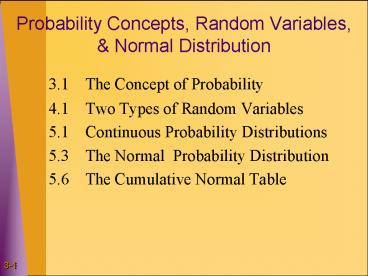Probability Concepts, Random Variables, - PowerPoint PPT Presentation
1 / 21
Title:
Probability Concepts, Random Variables,
Description:
3-1. Probability Concepts, Random Variables, & Normal Distribution. 3.1 The Concept of ... and e = 2.71828 is the base of natural or Naperian logarithms. 3-11 ... – PowerPoint PPT presentation
Number of Views:27
Avg rating:3.0/5.0
Title: Probability Concepts, Random Variables,
1
Probability Concepts, Random Variables, Normal
Distribution
- 3.1 The Concept of Probability
- 4.1 Two Types of Random Variables
- 5.1 Continuous Probability Distributions
- 5.3 The Normal Probability Distribution
- 5.6 The Cumulative Normal Table
2
3.1 Probability Concepts
An experiment is any process of observation with
an uncertain outcome. The possible outcomes for
an experiment are called the experimental
outcomes. Probability is a measure of the chance
that an experimental outcome will occur when an
experiment is carried out
3
Probability
If E is an experimental outcome, then P(E)
denotes the probability that E will occur
and Conditions If E can never occur, then P(E)
0 If E is certain to occur, then P(E) 1 The
probabilities of all the experimental outcomes
must sum to 1. Interpretation long-run relative
frequency or subjective
4
4.1 Random Variables
A random variable is a variable that assumes
numerical values that are determined by the
outcome of an experiment. Discrete random
variable Possible values can be counted or
listed. e.g. the number of defective units in a
batch of 20, a listener rating (on a scale of 1
to 5) in a AccuRating music survey. Continuous
random variable May assume any numerical value
in one or more intervals. e.g. the waiting time
for a credit card authorization, the interest
rate charged on a business loan. Generated by
measurement activities as opposed to counting
5
4.2 Discrete Random Variable Distributions
- Let X be a discrete random variable
- To specify the probability distribution of X we
list its possible values and their probabilities - Specification can be in the form of a table with
two columns, a formula, or a graph
6
Distribution of Dice Throw Outcome
7
5.1 Continuous Random Variable Distributions
- Let X be a continuous random variable
- To specify the probability distribution of X we
cannot list all its possible values and their
probabilities because they are infinite - Specification can only be in the form of a
formula or a graph based on the function f(x)
8
Continuous Probability Distributions
The curve f(x) is the continuous probability
distribution (or probability curve or probability
density function) of the random variable X if the
probability that X will be in a specified
interval of numbers is the area under the curve
f(x) corresponding to the interval.
Properties of f(x) 1. f(x) ? 0 for all x 2. The
total area under the curve of f(x) is equal to 1
9
Probability of a Single Value
- Area of a region under the graph represents
probability - For x a, the region is a line which has no area
- P(x a) 0
- Consequence of P(x a) 0
- P(x gt a) P(x gt a)
- P(x lt a) P(x lt a)
10
5.3 The Normal Probability Distribution
The normal probability distribution is defined by
the equation
- and ? are the mean and standard deviation, ?
3.14159 and e 2.71828 is the base of natural
or Naperian logarithms.
11
The Position and Shape of the Normal Curve
12
Three Important Areas under the Normal Curve
The Empirical Rule for Normal Populations
13
Probabilities Not Under Empirical Rule
But what if we want probabilities for multiples
of the standard deviation other than 1, 2 or 3
which are not covered by the Empirical Rule? We
first convert the normal variable to a standard
and use Standard Normal (Z) tables. See Table
A.11 on page 595
14
The Standard Normal Distribution
If x is normally distributed with mean ? and
standard deviation ?, then
is normally distributed with mean 0 and standard
deviation 1, a standard normal distribution.
15
5.6 The Cumulative Normal Table
The cumulative normal table gives probability of
being less than or equal any given z-value
The cumulative normal table gives the shaded area
16
Some Areas under the Standard Normal Curve
17
Some Areas under the Standard Normal Curve
18
Calculating Normal Probabilities
- Example 5.2
- The Car Mileage Case
- Procedure
- Formulate in terms of x.
- Restate in terms of relevant z values.
- 3. Find the indicated area under the standard
normal curve.
19
Calculating Normal Probabilities, Ex. 5.2
20
Finding Z Points on a Standard Normal Curve
Z.025 is the point on the horizontal axis of the
standard normal curve that gives the right tail
area equal to 0.025 To find the value of Z.025
using cumulative normal tables first find the
left tail area (1 0.025 0.9750) then search
in the body of the tables to find the z value
corresponding to that area
21
Finding X Points on a Normal Curve
Example 5.5 Finding the number of tapes stocked
so that P(x gt st) 0.05































